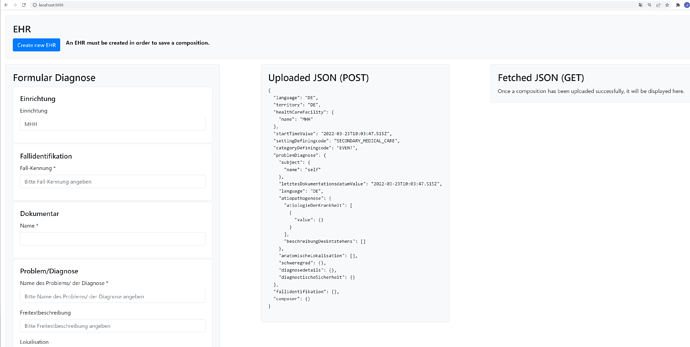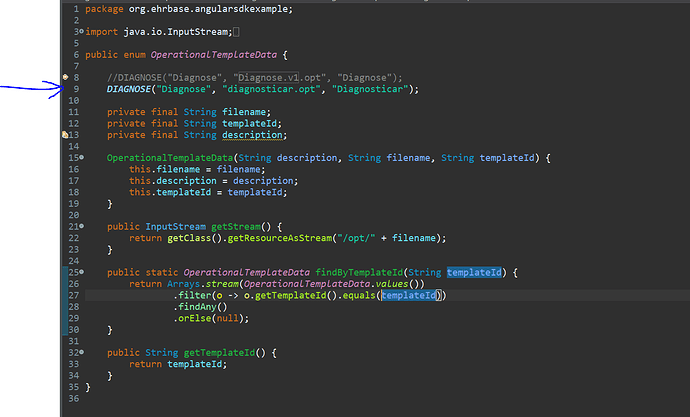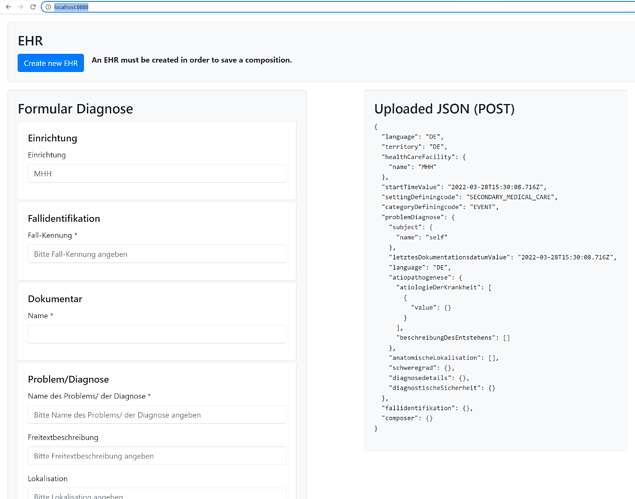openEMPI is more what you want. FHIR is currently the hyped solution, and the data points in the admin resources are reasonably comprehensive, but the modelling is terrible. This has been noted by many US companies BTW. The FHIR model would make more sense as a facade on something properly modelled, which could be the openEHR model (upgraded a bit).
Hi @thomas.beale and @pablo
I hope you are well.
Okay, I’m clear that I have to have 2 different systems defined.
In 1 system I will have the data of the patient, doctor, hospital, etc. and in the other system (OpenEhr) I will have defined the Compositions.
Now I have the following questions:
1- In which field of composition can the id of a patient or a doctor be indicated to relate it? Do you have any examples?
2- Difference between archetype and template?
3- Can I define new templates and new compositions created by me? Or do the templates and new compositions that I define have to be approved by someone?
Look forward your comments.
Many thanks for your help.
Kind regards,
Check composition.composer and ehr_status.subject in the specs
Hi Rafa,
I will try to send you an actual example tomorrow!
Hi all,
I hope you are well today.
Please, can you send me a simple java or json example to see where I can indicate the id of the PATIENT or the id of the Doctor?
I have read the documentation and I have understood that we have to have two separate systems.
Look forward your comments.
Thanks.
Hello @birger.haarbrandt
I hope you are well.
Please can you send me a sample java project indicating the external id of the doctor or patient in openehr?
I have managed to configure a REST API with patients and doctors with a PostgreSQL Database.
Look forward your comments.
Many thanks for your help.
Kind regards.
Please check the specs. The Reference Model shows the fields, the schemas define the JSON/XML and the REST API has examples.
Hello all,
I hope you are well.
I have followed your advice and set up the following 2 projects separately:
Afterwards, I managed to run the projects on localhost: 8888 (I see the form in German, how can I indicate the Spanish language and see everything on the form in Spanish?
Then, following my previous comments on this topic, how can I create 1 composition indicating a patient and linking to an external id?
Please, I have a long time with this topic open in the forum and I can not create a composition of an outpatient indicating an external id.
Can you please help me now that I have everything set up correctly?
I also need to change the language to Spanish or English. Best Spanish.
Please take a long time with this topic and I need some of you to help me now that I have everything set up. I am very interested in using these tools and platforms.
Look forwards your comments.
Many thanks for your help.
Kind regards.
@rafotis2 it seems you are not using the specs which is required to answer your questions.
Hi Rafa,
sorry for being so late to come back to you. The application you tried is a good learning example, but its is not exactly something that will give you things through convenience functions.
First, you will need a template that contains a Spanish translation. This can be achieved by using the Archetype Designer (Archetype Designer). The problem/diagnosis archetype is already ready available in Spanish: Clinical Knowledge Manager
You can download the archetypes and put them into your own repository inside the Archetype Designer. Once a template is created, you can export it in the language(s) of choice.
In a next step, you will have to reproduce the steps/structures that you find the example app: use the openEHR SDK to create DTOs and replace the ones you find there. The issue is that you still need to do some mapping towards the REST endpoints.
As an alternative, I recommend to use the WebTemplate format: 9.1. General Description — EHRbase documentation
This will give you a structure that is quite easy to process and will help you to get started a bit easier. You can also find examples how you can reference practitioners here: 9.2. RM-Mappings — EHRbase documentation
We are currently working on an “example” endpoint in EHRbase that will make your life easier to create a valid composition. This should hopefully become available within the next 3 weeks. Hope this helps a bit!
Good stuff Birger,
@Rafa - specifically for the WebTemplate FLAT format you would typically use
For an external identifier like a National patient number (using PARTY_IDENTIFIED)
{
"conformance-ehrbase.de.v0/composer|name": "Silvia Blake",
"conformance-ehrbase.de.v0/composer/_identifier:0|id": "122",
"conformance-ehrbase.de.v0/composer/_identifier:0|issuer": "issuer",
"conformance-ehrbase.de.v0/composer/_identifier:0|assigner": "assigner",
"conformance-ehrbase.de.v0/composer/_identifier:0|type": "type"
}
or for a direct reference into a demographics service (using PARTY_REF)
{
"conformance-ehrbase.de.v0/composer|name": "Silvia Blake",
"conformance-ehrbase.de.v0/composer|id": "1234-5678",
"conformance-ehrbase.de.v0/composer|id_scheme": "UUID",
"conformance-ehrbase.de.v0/composer|id_namespace": "EHR.NETWORK"
}
@ian.mcnicoll can we use either PARTY_IDENTIFIED or PARTY_REF for different compositions?
Yes, as I far as I understand things!!
I slightly misspoke above, PARTY_REF is available as part of PARTY_IDENTIFIED as external_ref, so can be used alongside as the formal identifiers, or instead of the formal identifiers.
is what is under the hood in the canonical representation
Hello @ian.mcnicoll and @birger.haarbrandt
I hope you are well.
Thanks for your help.
I will ask the most particular questions so that you can help me please.
Following my example, how can I indicate an archetype in Spanish to have all the fields in Spanish?
Please can you send me this archetype and tell me where I have to put it?
Please follow the example I have already prepared and change it to Spanish or send me the project in Spanish and I will try it.
I need to have an example as a test demo.
I am very interested in using this platform.
Look forward your comments.
Thanks for your help.
Kind Regards,
Hi Rafa, I gave you the link to the Archetype in my reply above. There is also a function within the CKM that allows you to download it (easy to find).
You then can upload this again in the Archetype Designer.
What I cannot do is provide is doing all the work for you. I’m happy to answer questions, and we can surely learn how to improve documentation.
I understand that there is some learning curve. Maybe the following training course would be a good starting point?
Hello @birger.haarbrandt and @pablo
I hope you are well today.
Please, can you send me the file in .opt format?
I have configured the 2 projects that I told you about and I am working and trying to learn but it is difficult for me. I assure you that my effort is maximum and I am reading documentation on Saturdays and Sundays to try to have a test demo.
I am willing to take the training course and pay for this training course but I need to have a demo.
I don’t know how to choose the .opt to indicate in the project. I have seen your link but I don’t see how to get the file in .opt format. I can only get this file in XML or ADL but not in .opt.
Please, can you send me the file in .opt format?
Look forward your comments.
I am very grateful for all your help.I am very grateful for all your help.
Many thanks my friend.
Kind regards,
Please find attached
diagnosticar.opt (52.3 KB)
(Edit: as mentioned above (please read carefully, you need to download the archetype, add it to the Archetype Designer and build your template within the Archetype Designer. There you can also choose languages for the export).
@rafotis2 I know it’s though, I’ve been there!
We have openEHR training courses in Spanish and English at CaboLabs Health Informatics, Standards and Interoperability
Hello @birger.haarbrandt and @pablo
I hope you are well today.
I am very grateful to you 2. I greatly admire your help and I appreciate it.
If I can pay you then I will.
I have put this attached template from @birger.haarbrandt “diagnose.opt” in src/main/resources/opt and I have changed the OperationalTemplateData.java class. This is the result:
But I can’t get the text of the form to appear in Spanish. I don’t know the reason.
Please can you help me?
How can I generate the java classes in Spanish?
I am willing to repay you for all your help.
I am very grateful to all of you.
Many thanks for your help.
Kind regards,
The OPT is single language, check the XML and you will see the language of the template is “en”. When you export the OPT you need to choose the language or you need to start the tool you are using with the parameter to work in “es” language, this depends on the tools you use. I use the Ocean Template Designer which needs a -l parameter to start in the desired language, something like -l:es-ES





